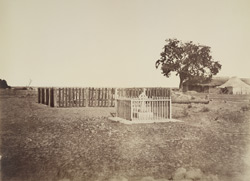 |
| Cawnpore memorial (UP), India collection.nam.ac.uk |
Above image: The Angel of Pity' in the Memorial Garden, Cawnpore, 1867...........
 |
| Bibigarh well, Cawnpore (UP) 1857. bl.uk |
Above: Bibigarh, Cawnpore. well (now barricaded) where bodies were thrown in. Photo taken in 1858 by Major Robert Christophe.........................
''During the Indian Rebellion (1857-1859) by the Indian soldiers against the East India company's atrocities places like Cawnpore, Delhi, Lucknow and Meerut (where it began in June 1857) in the north Indian states became scenes of rioting and rampage, hell holes of mayhem and confusion. The bodies of several of the victims of the Cawnpore massacre were thrown down this well near the Bibigarh meaning the "House of Women," and it refers to a house originally built” by a British officer in Cawnpore for his Indian mistress in July 1857.
 |
| Cawnpore where massacre took place, alamy.com |
A small memorial came up at the well site after Cawnpore was recaptured by the British forces. This was later replaced by a Memorial Garden over which Carlo Marochetti's angel and Henry Yule's memorial screen were erected. The inhabitants of Cawnpore were forced to swallow the cost of the memorial ie £30,000 as a sort of punishment for the massacre. The funny thing is they had nothing to do with the massacre. For about 85 years it was the iconic site of imperial remembrance in the British Raj. It is said in the later part of the 19th century it was visited more frequently by Europeans than the Taj Mahal. After India's independence in 1947 the monument was removed in 1949.
The idea of a suitable memorial was mooted by Charlotte, Countess Canning (1817-61) and her sister Louisa Anne Beresford, Marchioness of Waterford (1818-91) with the figure of an angel executed by Baron Carlo Marochetti (1805-67) and a screen by Colonel Sir Henry Yule (1820-89) and C. B. Thornhill, Commissioner of Allahabad and superintending architect. (see Keene 44, and "The Cawnpore Memorial"). Photographic print from a Photograph by Samuel Bourne, 1865. Courtesy of the British Library's Online Gallery.
The Merciless killing of seventy-three women and 124 children at Cawnpore in July was said to be a horrible and the single most traumatic episode of the uprisings of 1857. Some historians like David come up with a casualty figure of 254. This unexpected turn of event and the resultant tragedy had a deep impact on the British psyche because it was the first time that women and children became the victims of the British men's atrocities and consequently they took the brunt of native hostility.
In the aftermath, it got the worst out of the British indulging in acts of retaliation in other places. This resulted in the death of a million Indians over a period of time according many historians. Brigadier Neil, Gen. Havelock and Officer William Raikes Hodson alone killed Indian natives in thousands. The latter, after the recapture of Delhi in 1857 not only captured the three heirs of the last Mogul ruler (aged 82) Bahadur Shah Zafar but also executed them point blank in the presence of a huge tumultuous crowd near the famous Khooni Gate Delhi. Before execution, they were stripped of their signet rings, turquoise arm bands and bejeweled swords. The princes' bodies were ordered to be displayed in front of a kotwali, or police station, and left there to rot and to be seen by all so that people won't raise their voice against the English company.
Amaresh Misra, a writer and historian based in Mumbai, “It was a holocaust, one where millions disappeared. It was a necessary holocaust in the British view because they thought the only way to win was to destroy entire populations in towns and villages. It was simple and brutal. Indians who stood in their way were killed. But its scale has been kept a secret,” Misra said.
His conclusion is based on three principal sources. Two are records pertaining to the number of religious resistance fighters killed – either Islamic mujahideen or Hindu warrior ascetics committed to driving out the British.
The third source being British labour force records: They show a drop in manpower of between a fifth and a third across vast swaths of India, which as one British official records was “on account of the undisputed display of British power, necessary during those terrible and wretched days – millions of wretches seemed to have died.'
While the British forces vented their anger, to the growing dismay of Lord Canning and others – "I protest against meeting atrocities with atrocities," declaimed Disraeli (qtd. in Dalrymple) – two women planned a more substantial memorial for the defenseless victims of the uprising, who had met such brutal deaths.
https://collection.nam.ac.uk/detail.php?acc=1957-04-30-19
https://www.dawn.com/news/262820/millions-died-after-1857-war-of-independence-historian









